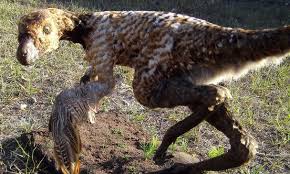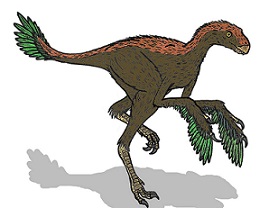
Protarchaeopteryx is an intriguing Dinosaur from the Early Cretaceous period, approximately 120 million years ago. While it may not be as famous as some other feathered dinosaurs like Archaeopteryx, Protarchaeopteryx holds a significant place in the study of dinosaur evolution and the origin of birds. In this 500-word exploration, we'll delve into its classification, physical characteristics, habitat, behavior, and its role in our understanding of feathered dinosaurs and avian evolution.
Protarchaeopteryx belongs to the group of theropod dinosaurs, which includes famous carnivorous dinosaurs like Tyrannosaurus rex and Velociraptor. What sets Protarchaeopteryx apart is its classification within the Maniraptora clade, a group that includes the closest relatives of birds. This places it in the spotlight of avian evolution.
| Name: | Protarchaeopteryx dinosaurs |
| Size: | Around 2.5 feet (0.8 meters) in length , 2 to 3 kilograms (4.4 to 6.6 pounds). |
| Main Facts: | Protarchaeopteryx possessed primitive feathers, providing insights into avian evolution despite its inability to achieve powered flight. |
The first fossils of Protarchaeopteryx were discovered in China in the early 1990s, specifically in the Yixian Formation of Liaoning Province. These fossils, including remarkably well-preserved specimens, have provided crucial insights into the early stages of feathered dinosaurs and their connection to modern birds.

Protarchaeopteryx was a small dinosaur, estimated to be about 2.5 feet (0.8 meters) in length. It had a slender, bird-like body and long legs, characteristics associated with theropod dinosaurs. However, what makes Protarchaeopteryx truly remarkable is its feathers.
Fossil evidence shows that Protarchaeopteryx had a covering of primitive feathers, resembling more downy structures rather than the flight feathers of modern birds. These feathers likely provided insulation and possibly played a role in display or camouflage.
While Protarchaeopteryx had feathers, it did not possess the adaptations for powered flight seen in modern birds. Instead, it is considered a transitional form, representing a stage in the evolution from feathered dinosaurs to true birds.
Protarchaeopteryx lived in a lush, forested environment during the Early Cretaceous period. This habitat provided an abundance of plant and animal life, which would have been essential for its survival.
Regarding behavior, much of what we know about Protarchaeopteryx is inferred from its close relatives and the presence of feathers. It likely had a bipedal stance, similar to other theropod dinosaurs, and may have been an omnivore or herbivore, as many Maniraptoran dinosaurs displayed dietary flexibility..
Protarchaeopteryx is significant because it adds a piece to the puzzle of avian evolution. Its feathered body, while not adapted for flight, suggests a connection between non-avian dinosaurs and modern birds. These primitive feathers may have provided insulation, helping to regulate body temperature
The presence of feathers on dinosaurs like Protarchaeopteryx challenges the traditional view of dinosaurs as scaly reptiles. Instead, it supports the idea that feathers initially evolved for purposes other than flight, such as insulation or display, and were later co-opted for powered flight in avian evolution.
Protarchaeopteryx was a small, feathered dinosaur from the Early Cretaceous period, measuring about 2.5 feet in length. Its body featured primitive feathers, likely used for insulation or display rather than flight. It had a slender, bird-like build with long legs, typical of theropod dinosaurs.
Fossils of Protarchaeopteryx have been found in China's Liaoning Province, contributing to our understanding of the transition from feathered dinosaurs to modern birds. While not capable of powered flight, this dinosaur represents a significant link in the evolutionary chain, highlighting the gradual development of feathers and avian traits among its dinosaurian relatives.
Protarchaeopteryx, a feathered dinosaur from the Early Cretaceous period, shares both similarities and differences with other dinosaurs, offering insights into the complex web of prehistoric life.
Protarchaeopteryx is classified as a theropod dinosaur, a group characterized by bipedal locomotion, sharp teeth, and often, carnivorous habits. This classification links it to various other theropods, such as Velociraptors and Tyrannosaurus rex.
Protarchaeopteryx had primitive feathers, suggesting that feathered structures may have evolved earlier in dinosaur evolution than previously thought. Feathers are now known to be a common feature among theropods.
Unlike some other feathered dinosaurs like Archaeopteryx, Protarchaeopteryx was not adapted for powered flight. Its feathers were likely used for insulation or display rather than for flying.
Protarchaeopteryx was relatively small, measuring about 2.5 feet in length, whereas some other theropods like Tyrannosaurus rex reached lengths of up to 40 feet or more.
While Protarchaeopteryx's exact diet remains speculative, it is thought to have been omnivorous, consuming plants and small animals. This differs from the strictly carnivorous habits of some other theropods.
Protarchaeopteryx fossils have been found in China's Liaoning Province, while some other theropods lived in different regions and geological periods.
The cranial structure of Protarchaeopteryx, including its beak-like snout, differs from the skull features of some other theropods, reflecting variations in feeding adaptations.